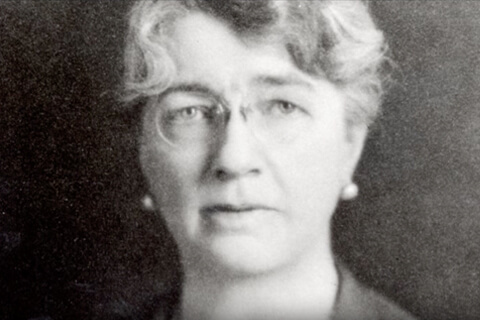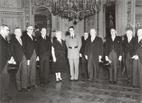Biography: Dr. Louise Pearce

Louise Pearce, M.D., a physician and pathologist, was one of the foremost women scientists of the early 20th century. Her research with pathologist Wade Hampton Brown led to a cure for trypanosomiasis (African Sleeping sickness) in 1919.
Born in Winchester, Massachusetts, in 1885, Louise Pearce graduated from Stanford with a bachelor's degree in physiology in 1907, an unusual degree for a woman student at that time. She attended Boston University School of Medicine, and after two years transferred to John Hopkins University School of Medicine in Baltimore, where she followed in the footsteps of pioneering women doctors Dorothy Reed Mendenhall and Florence Sabin. Louise Pearce was awarded her M.D. degree at Johns Hopkins in 1912.
After working for a year as house officer in the university hospital, she wrote to Simon Flexner, director of the Rockefeller Institute in New York City, requesting a position. When Flexner received Dr. Pearce's letter of application, he relished the idea of including a woman on the Institute's scientific staff. In 1913, when asked her opinion of being the first woman to work directly with Flexner, Dr. Pearce responded with a smile, "I just think it's ripping."
After the 1910 discovery of Salvarsan, an arsenic-based treatment for syphilis, scientists had high hopes for the development of other drugs. Flexner asked his team to try to find another arsenical compound for use against trypanosomiasis—African sleeping sickness. They found a compound, later called tryparsamide, to be highly effective in destroying the infectious agent of sleeping sickness in animals. Pearce and Brown announced their successful results in the Journal of Experimental Medicine in 1919. But now they would need to test the drug on humans.
In 1920, when a severe outbreak of the disease broke out in the Belgian Congo, (Zaire), Dr. Pearce, then 35 years old and attracted by the adventures of field research, volunteered to go alone to Leopoldville to test the new drug. Studying the effect of each dose of tryparsamide on more than seventy patients, Pearce saw the parasites were completely eradicated within a few weeks of the treatment. Belgian officials, impressed and grateful for her results, awarded her the Ancient Order of the Crown and elected her a member of the Belgian Society of Tropical Medicine. Three decades later, in 1953, she was called to Brussels to receive the King Leopold II prize and a check for ten thousand dollars.
After the excitement of her successes in the Belgian Congo, Dr. Pearce returned to Rockefeller Institute in New York and was promoted to associate member in 1923. She began to work with Wade Hampton Brown on his life's research on susceptibility or resistance to infection, and continued her syphilis research and experimented with tryparsamide's ability to reach the central nervous system. Working with Dr. Brown, the team discovered in one rabbit a small cancer of the scrotum that they found they could transplant from one rabbit to another. The Brown-Pearce tumor, for many years the only transplantable tumor of the rabbit, was studied in cancer research laboratories worldwide. By 1940, more than two dozen hereditary diseases and deformities were represented in the rabbit colony. Following Brown's death in 1942, Dr. Pearce focused on writing up her findings until her retirement in 1951.
Louise Pearce spent her last years at Trevanna Farm, in Skillmann, New Jersey, a home she shared with author Ida A. R. Wylie and the noted New York City public health physician S. Josephine Baker. Dr. Pearce died in the summer of 1959 after a short illness.
Dr. Pearce received numerous honors during her career. She went to China to serve as a visiting professor of syphilology at Peiping Union Medical College from 1931 to 1932. and served on the scientific advisory council of the American Social Hygiene Association. She did much to advance the cause of women in the fields of medicine and science. In 1941, she was elected to the "Board of Corporators" of the Woman's Medical College of Pennsylvania and was president of the school from 1946 to 1951.

Dr. Louise Pearce
Dr. Louise Pearce
Dr. Louise Pearce volunteered to go alone to the Belgian Congo in 1920 to test a new drug she hoped would cure African sleeping sickness, a disease that was often fatal. She received her M.D. from The Johns Hopkins University in 1912. Looking for work, she wrote to Dr. Simon Flexner, Director of the Rockefeller Institute in New York City, requesting a research position. Dr. Flexner supported her application, and Dr. Louise Pearce became the first woman to work directly with him. In 1910, an arsenic-based drug called Salvarsan was found to be an effective treatment for syphilis. Scientists had hopes of developing other arsenic-based drugs. Dr. Flexner asked his research team to try and find an arsenical compound for use against African sleeping sickness. They succeeded. Tryparsamide, they found, destroyed the infectious agent of sleeping sickness in animals. In 1919, these results were announced in the Journal of Experimental Medicine. A severe outbreak of African sleeping sickness broke out in the Belgian Congo in 1920. While in Africa, Dr. Pearce administered and studied the effects of the tryparsamide on seventy patients. The results were spectacular: the parasites were driven from circulating blood within days and totally eradicated within weeks. Symptoms cleared up and general health was restored in a large proportion of even the most severe cases. Belgian officials were impressed by the results. Dr. Pearce was awarded the Ancient Order of the Crown and elected a member of the Belgian Society of Tropical Medicine. Three decades later, in 1953, she was invited to Brussels to receive the King Leopold III Prize and an award of ten thousand dollars. After her success in the Belgian Congo, Dr. Pearce returned to the Rockefeller Institute, and was promoted to Associate Member in 1923. Teamed with Dr. Wade Hampton Brown, she studied susceptibility and resistance to infection. They discovered they could transplant certain cancers from one rabbit to another. The Brown-Pearce tumor was the first known transplantable tumor, aiding research into malignant tumors in cancer laboratories around the world. By 1940, more than two dozen hereditary diseases and deformities were studied in the tumors of the research team's rabbits. After the death of Wade Hampton Brown in 1942, Dr. Pearce focused on writing up their research findings, until her retirement in 1951. After a short illness, she died at her home in New Jersey in 1959.





